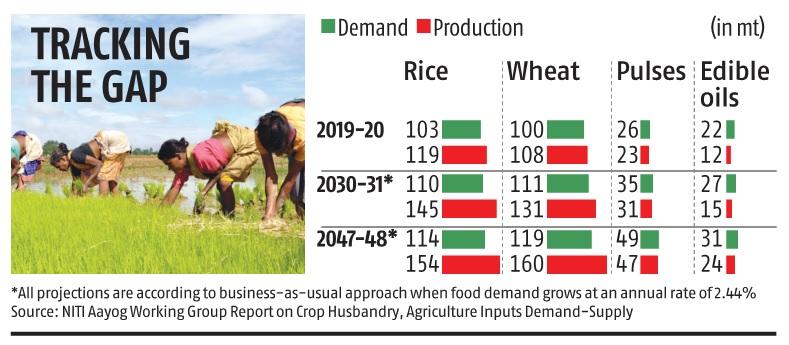
Amid protests by farmers at the Punjab-Haryana border demanding legalisation of minimum support price (MSP), a new NITI Aayog report has highlighted the urgent need to diversify from wheat and rice to pulses and oilseeds to bridge the demand-supply gap by 2047-48.
According to the report of the working group on demand and supply projections in agriculture, released on Tuesday, under a business-as-usual scenario, India’s pulses production will rise to around 47 million tonnes (mt) by 2047-48 from around 23 mt in 2019-20, while demand will grow to almost 49 mt during this period, leaving a gap of almost 2 mt.
“Their present production (of pulses) is insufficient to meet the demand. This gap may remain in future in the absence of yield improvements and acreage allocation to them,” the report said.
For edible oils, too, the report projected the demand to rise to around 31 mt by 2047-48 from 22 mt in 2019-20, and estimated the production of edible oils would grow to around 24 mt from 12 mt during the same period — a demand-supply gap of around 7 mt.

In contrast, the report said, rice demand is expected to be 110 mt in 2030-31 and 114 mt in 2047-48, compared with a projected production of 145 mt and 154 mt in the business-as-usual scenario.
The report said wheat production, too, was expected to be sufficient to meet the future demand, leaving a surplus of 19-26 mt in 2030-31 and 40-67 mt in 2047-48. “This suggests the need for a reallocation of area under rice and wheat to other crops,” the report said.
In an attempt to break the logjam in talks with protesting farmers, the Centre earlier this week proposed to buy marketable surplus in the cases of masoor (lentil), urad (black gram), arhar, maize, and cotton over the next five years at their MSPs.
According to the proposal that the farmer unions rejected, the purchases will be under a contractual agreement from those who have diversified from wheat and paddy.
The latest NITI Aayog report has made all the demand and production projections based on two scenarios – business as usual, where the forecast is based on time series, and high-yield growth scenario, which assumes closing the gap between the existing and realisable potential yield.
The report states that in the business-as-usual scenario — that is, the continuance of the recent economic growth rate (6.34 per cent) in the future as well — the overall food demand is expected to grow at an annual rate of 2.44 per cent by 2047-48. It would accelerate to 3.07 per cent if the economic growth accelerated.
Food demand comprises demand for household, food away from home, feed, seed, wastages, and other uses.
Overall, for food grains, the NITI report said that demand in 2030-31 was estimated at 326 mt to 334 mt, and in 2047-48 at 402 mt to 437 mt.
The projected foodgrain production in the business-as-usual is 10-13 per cent (34-42 mt) more than the demand in 2030-31, and 5-14 per cent (22-55 mt) more in 2047-48.
First Published: Feb 22 2024 | 12:20 AM IST



